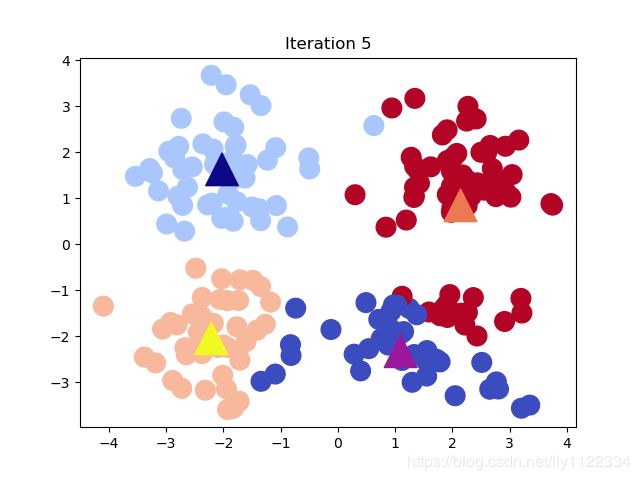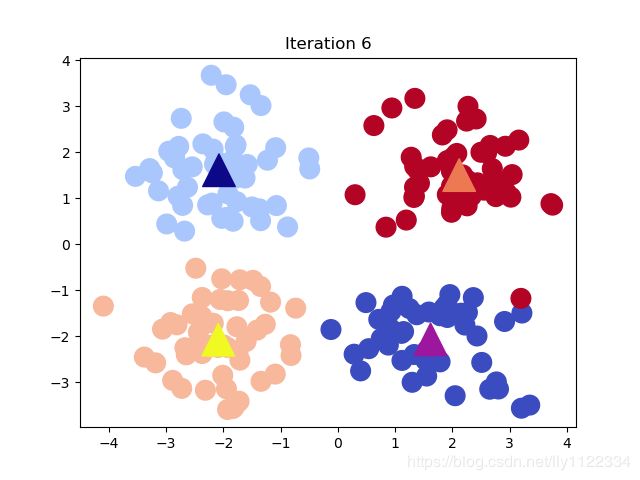import tensorflow as tf
import numpy as np
import time
import matplotlib.pyplot as plt
from sklearn.datasets.samples_generator import make_blobs
from sklearn.datasets.samples_generator import make_circles
DATA_TYPE = 'blobs'
N=200
if (DATA_TYPE == 'circle'):
K=2
else:
K=4
MAX_ITERS = 1000
start = time.time()
centers = [(-2, -2), (-2, 1.5), (1.5, -2), (2, 1.5)]
if (DATA_TYPE == 'circle'):
data, features = make_circles(n_samples=200, shuffle=True, noise= 0.01, factor=0.4)
else:
data, features = make_blobs (n_samples=200, centers=centers, n_features = 2, cluster_std=0.8, shuffle=False, random_state=42)
fig, ax = plt.subplots()
ax.scatter(np.asarray(centers).transpose()[0], np.asarray(centers).transpose()[1], marker = 'o', s = 250)
plt.show()
fig, ax = plt.subplots()
if (DATA_TYPE == 'blobs'):
ax.scatter(np.asarray(centers).transpose()[0], np.asarray(centers).transpose()[1], marker = 'o', s = 250)
ax.scatter(data.transpose()[0], data.transpose()[1], marker = 'o', s = 100, c = features, cmap=plt.cm.coolwarm )
plt.show()
points=tf.Variable(data)
cluster_assignments = tf.Variable(tf.zeros([N], dtype=tf.int64))
centroids = tf.Variable(tf.slice(points.initialized_value(), [0,0], [K,2]))
sess = tf.Session()
sess.run(tf.initialize_all_variables())
sess.run(centroids)
rep_centroids = tf.reshape(tf.tile(centroids, [N, 1]), [N, K, 2])
rep_points = tf.reshape(tf.tile(points, [1, K]), [N, K, 2])
sum_squares = tf.reduce_sum(tf.square(rep_points - rep_centroids), reduction_indices=2)
best_centroids = tf.argmin(sum_squares, 1)
did_assignments_change = tf.reduce_any(tf.not_equal(best_centroids, cluster_assignments))
def bucket_mean(data, bucket_ids, num_buckets):
total = tf.unsorted_segment_sum(data, bucket_ids, num_buckets)
count = tf.unsorted_segment_sum(tf.ones_like(data), bucket_ids, num_buckets)
return total / count
means = bucket_mean(points, best_centroids, K)
with tf.control_dependencies([did_assignments_change]):
do_updates = tf.group(centroids.assign(means), cluster_assignments.assign(best_centroids))
changed = True
iters = 0
fig, ax = plt.subplots()
if (DATA_TYPE == 'blobs'):
colourindexes=[2,1,4,3]
else:
colourindexes=[2,1]
while changed and iters < MAX_ITERS:
fig, ax = plt.subplots()
iters += 1
[changed, _] = sess.run([did_assignments_change, do_updates])
[centers, assignments] = sess.run([centroids, cluster_assignments])
ax.scatter(sess.run(points).transpose()[0], sess.run(points).transpose()[1], marker = 'o', s = 200, c = assignments, cmap=plt.cm.coolwarm )
ax.scatter(centers[:,0],centers[:,1], marker = '^', s = 550, c = colourindexes, cmap=plt.cm.plasma)
ax.set_title('Iteration ' + str(iters))
plt.savefig("kmeans" + str(iters) +".png")
ax.scatter(sess.run(points).transpose()[0], sess.run(points).transpose()[1], marker = 'o', s = 200, c = assignments, cmap=plt.cm.coolwarm )
plt.show()
end = time.time()
print("Found in %.2f seconds" % (end-start)), iters, "iterations"
print("Centroids:")
print(centers)
print("Cluster assignments:", assignments)

















